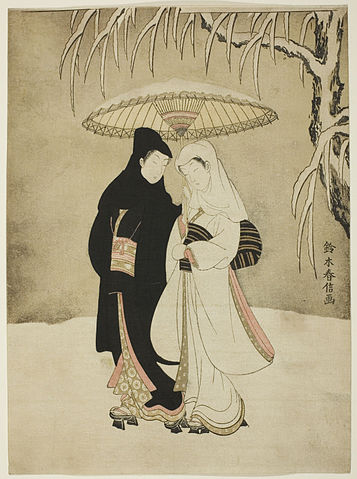Happy Sunday! Today, we will dissect another Basho poem. So, grab a cup of coffee and let's dig in!
But first, did you get our latest Makoto issue?
If you aren't a member, give our free trial a try and download the new issue instantly.
If you are a member, you can find the download links here: Samurai and Shogun
----
And now, today's Sunday Haiku:
Today's haiku is by 松尾 芭蕉【まつお ばしょう】. Matsuo Basho (1644-1694) is the most famous of the classical haiku poets, and today's haiku reminds us love and youthful playfulness can come at any time.
Makoto+ Shogun or Lifetime members, click here for today's haiku with sound and almost 100 other haiku lessons. (Not yet a member, let's fix that!)
Haiku lesson
Let's get right to it.
いざ行かん 雪見に転ぶ 所まで
VOCABULARY
- いざ行かん come on, let’s go [いざ (now) + 行かん (dialectal form of 行こう (let’s go; volitional form of 行く (to go))); 行く has two readings: いく and ゆく. The meaning is the same, but ゆく may have a more poetic or old-fashioned feel to it.]
- 雪見 snow viewing
- に in; into; during
- 転ぶ to fall down; to fall over
- 所まで up to the point [所 (point; place; spot) + まで (up to; until (a time); till)]
季語【きご】 Season Word
What is the 季語【きご】? It is 雪見【ゆきみ】 (viewing snow) which makes this a winter poem.
You've surely heard of 花見【はなみ】 where Japanese have picnics under the falling cherry blossoms in the spring. And in the fall, there is 月見【つきみ】 (moon viewing). And in Edo (modern day Tokyo) where it didn't snow much, people also enjoyed viewing snow.
Interpretation
This poem was written in 1688 and revised over the next year by Basho.
Two Lovers Beneath an Umbrella in the Snow, Color woodblock print by 鈴木 春信 Suzuki Harunobu
A Romantic Poem?
Could this be Basho inviting a young lady to frolic with him in the snow? It's certainly a playful image. Let's go run through the snow, hand-in-hand, totally free of care... until we tumble and fall.
It's childish and silly but perhaps a little romantic too. Let's have fun in the snow, just the two of us. The vast, silent snow blankets and shields us from anyone else. There's no one in the world but us two.
Basho was about 43 when he wrote this. He was a fully-grown adult. But perhaps he met somebody new and felt a sudden rush of youthful playfulness despite his age.
At any rate, he is asking someone to rush in the snow with him. The いざ that starts the poem may indicate a sudden idea that popped into his head. He wants someone to stay with him until they both slip and fall with laughter (indicated by the ころぶ所まで).
He could be talking to a child and wanting to accommodate that child's desire to frolic in the snow, but perhaps more likely he is infatuated with some lady and has become a child again in his heart.
Note how the haiku begins with the call to action. いざ行かん! Well now, let's go! And ends with his real purpose (maybe), to playfully fall down in the snow with his lover.






